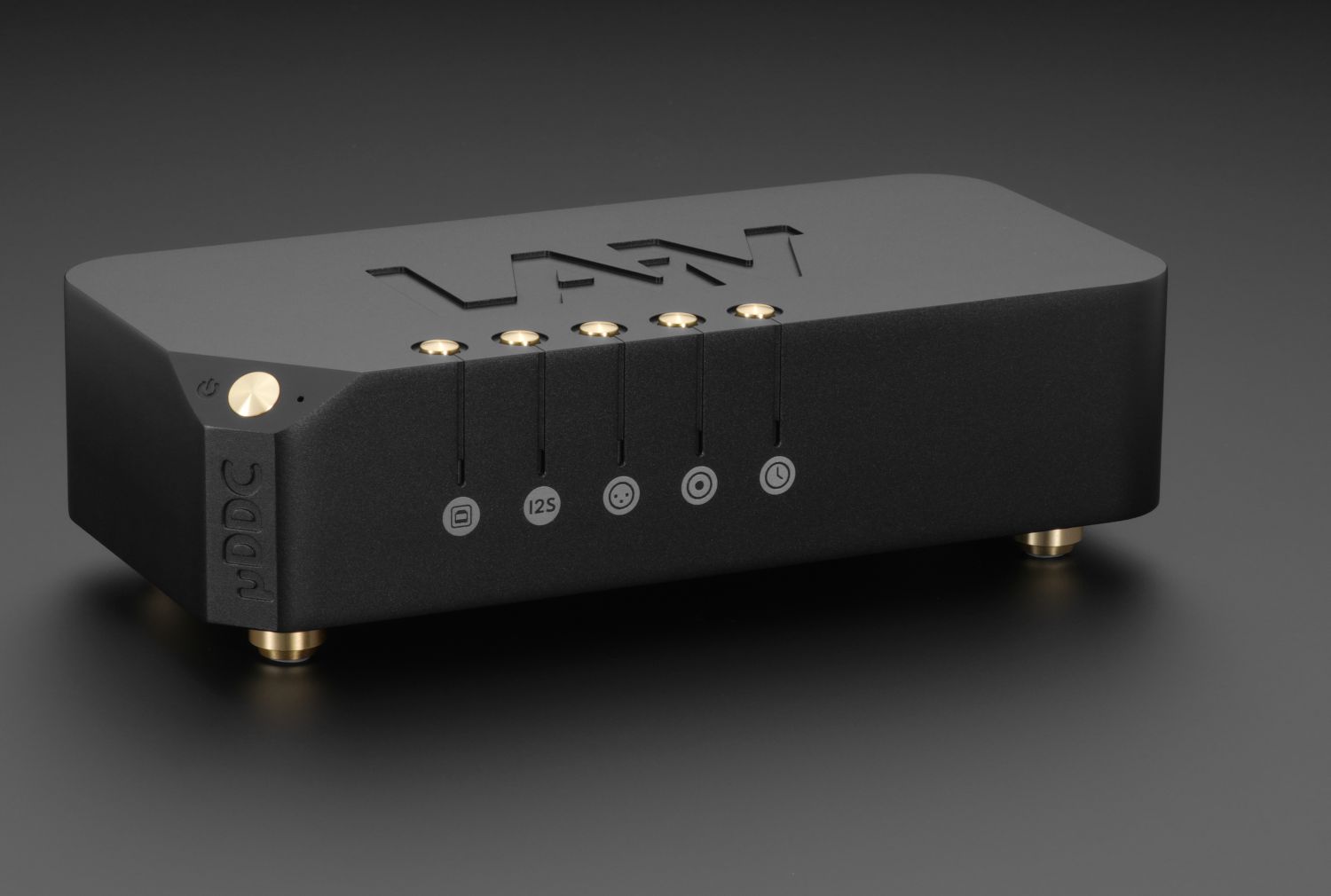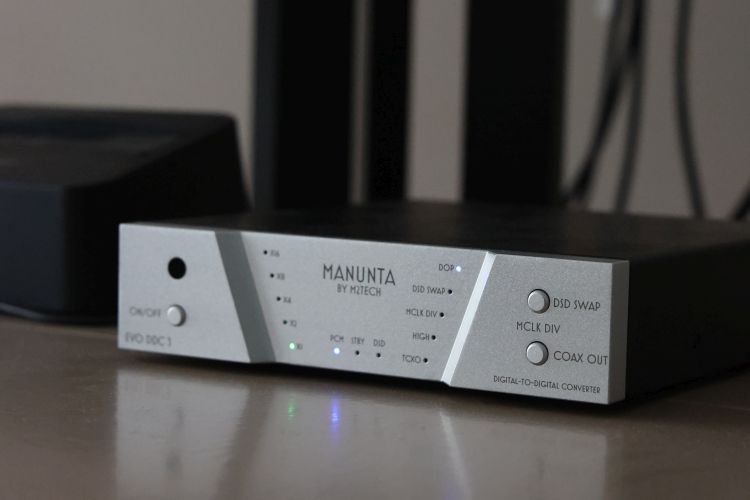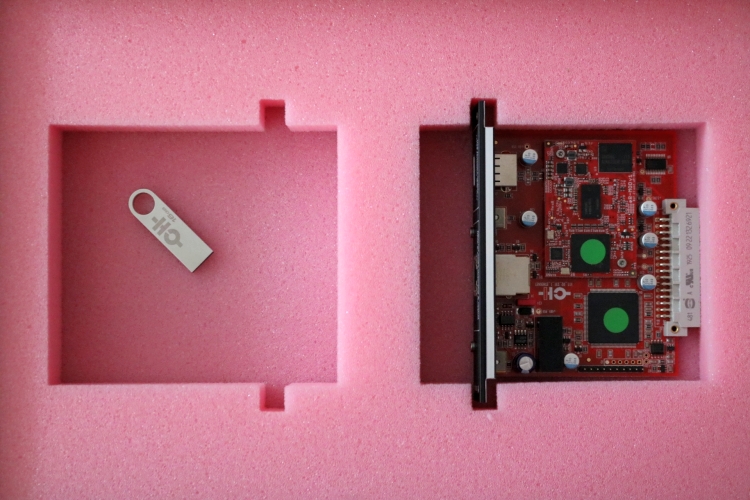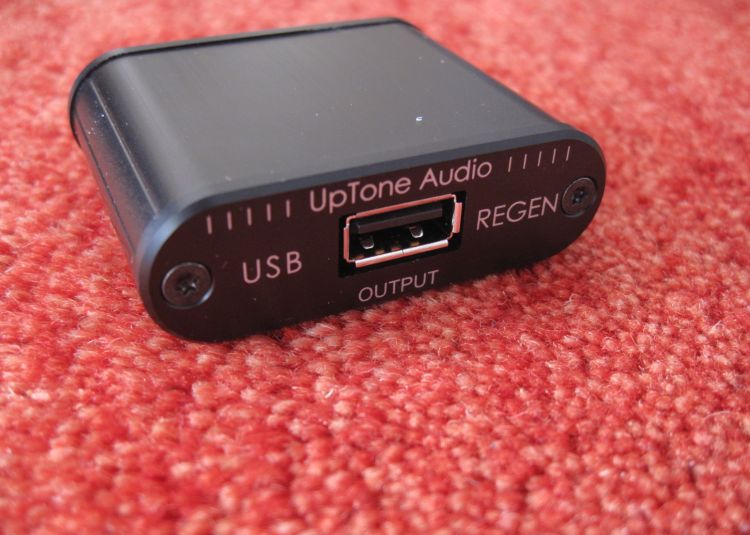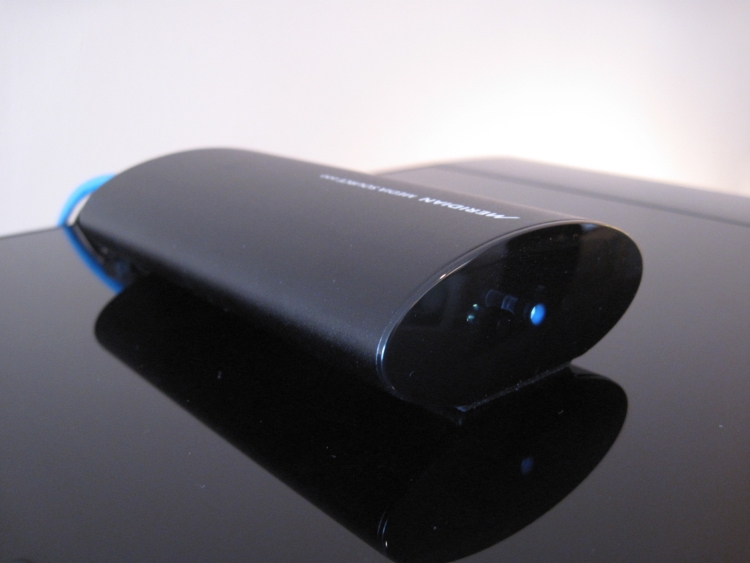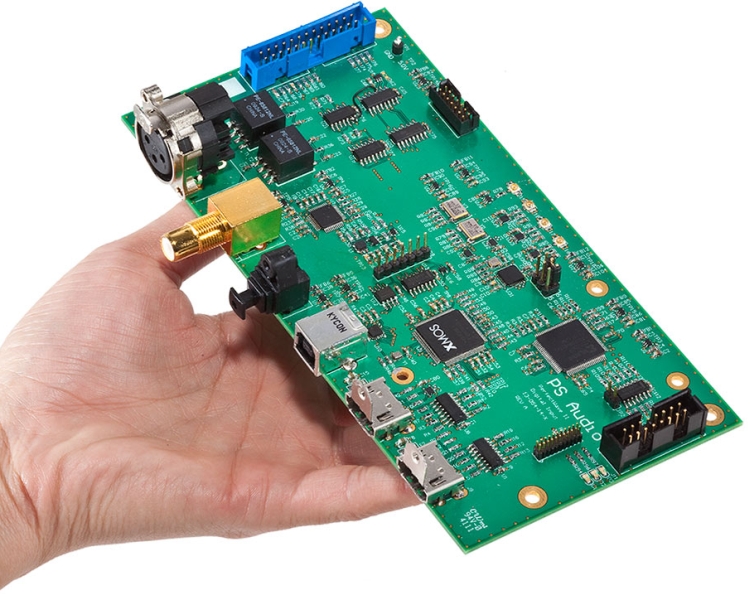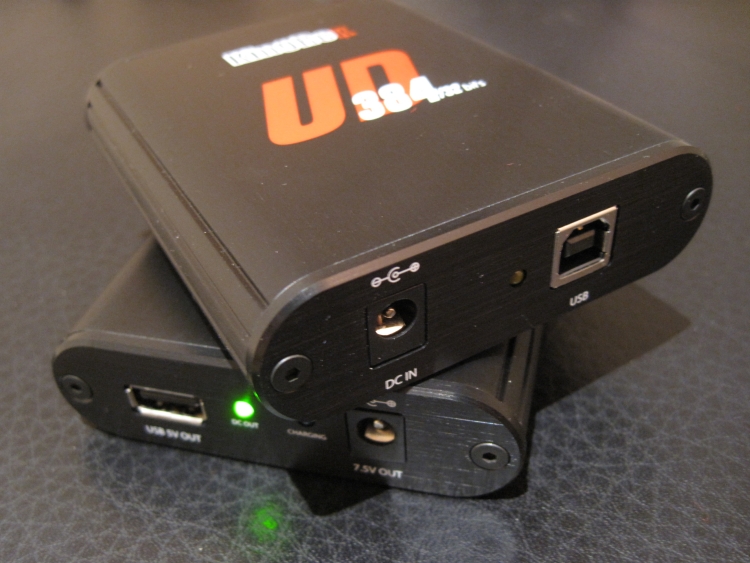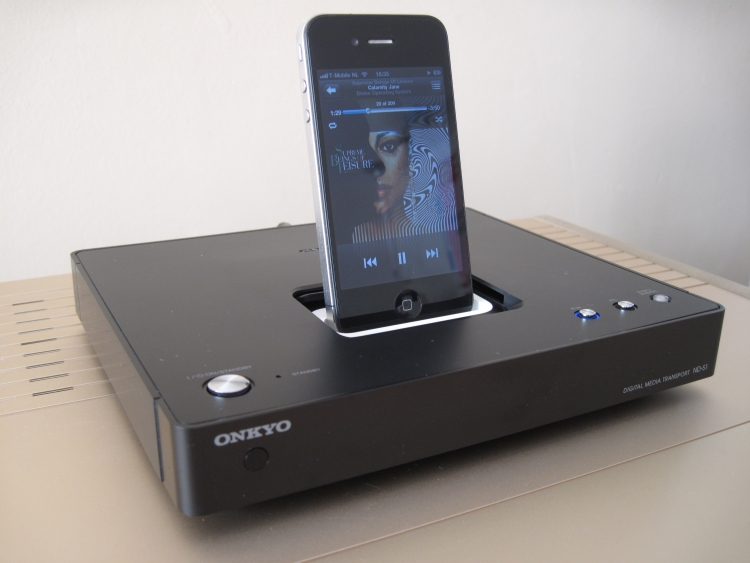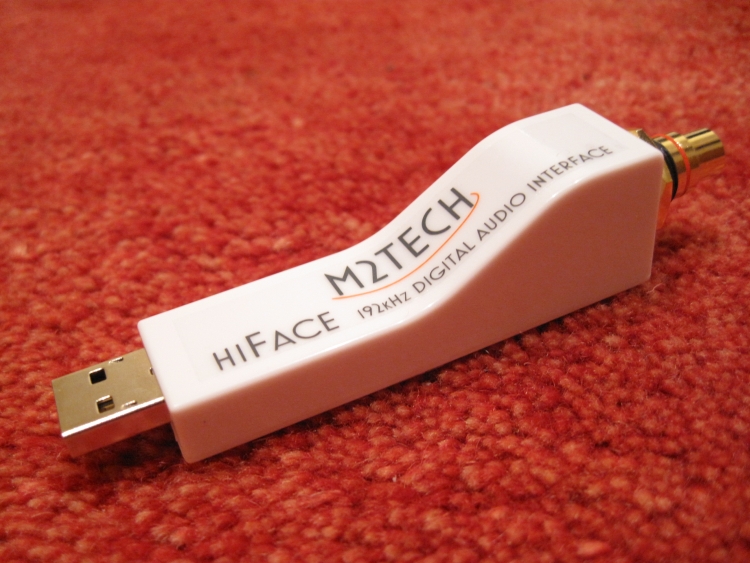
Introduction
The M2Tech HiFace is a miniature USB to SPDIF converter. It is plug-and-play as soon as you’ve installed the drivers. There are Windows and Mac drivers for both DirectSound and Kernel Streaming. This makes the unit compatible with any player application, but Kernel Streaming is the way to go if you want maximum sound quality. In that case, the drivers aren’t available for any and all apps, but at least for the most widely used ones, such as iTunes and Winamp. The drivers make it possible to play and stream 192khz material (using kernel streaming), whereas USB is normally restricted to a maximum of 96khz. Inside is a high-accuracy clock and circuitry that makes the HiFace the master in the asynchronous process, thereby controlling the accuracy of the timing, not the other way around.
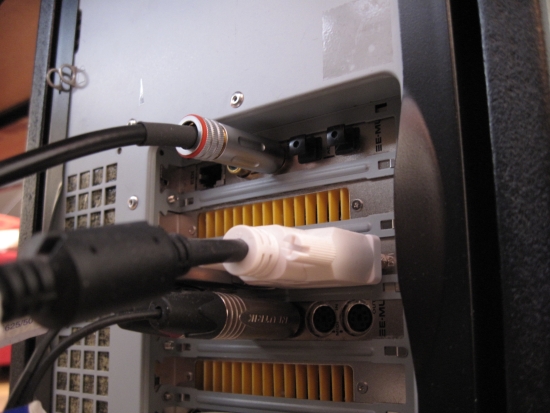
Above: EMU1212M soundcard digital out, connected to a 10m long Belden RG59 coaxial digital cable
Installing
This is really easy. Just double-click setup, and away you go. Anyone who has installed anything on a computer before should be able to pull this off. The program installs everything by itself, at least on Windows, but I have a feeling that it’s the same for Mac. After installing (on Win) you will find a direct output for the Hiface in the preferences of your player of choice. In my case, this was Winamp. You can choose the output in DirectSound or in Kernelstreaming mode. They both work but there is a marked difference in sound. More about this later on. After the drivers have been installed, the device is truly plug-and-play. Just don’t – like I did – unplug it while the music is playing. It made the application crash badly, and I had to reset the computer to get past this. After that, everything worked smoothly again.
I also tested the HiFace with a Macbook Pro but didn’t witness the installation procedure. But I did listen to it extensively. On my PC, I compared the HiFace directly to the S/PDIF output from my semi-pro EMU1212M soundcard, using the same cable and DAC. I had nothing to compare it with on the Mac since the Macbook Pro has no other means of connecting to my DAC except the built-in Toslink, but that is no contest.
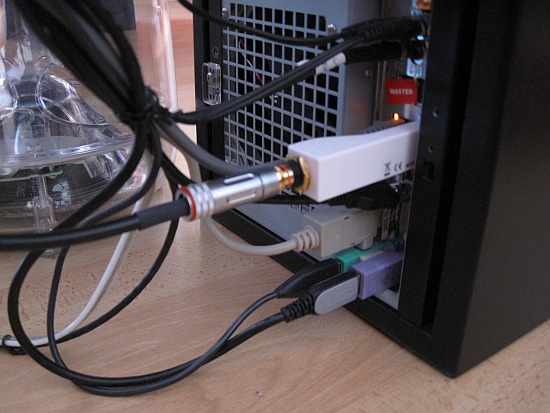
Above: HiFace in a USB port, connected to a 10m long Belden RG59 coaxial digital cable
Sound
On the Macbook, in a friend’s system, I could only compare it to the resident Logitech Squeezebox, consisting of a NAS and Sqeezebox, connected via digital coax cable to the Wadia 27ix GNSC DAC. The Sqeezebox has already disappointed me earlier, see this review, and listening to the HiFace output was another matter altogether. Where the Squeezebox was friendly, rounded, undynamic, and, ultimately, very uninvolving, the HiFace was fast, dynamic, and punchy. Now, the system was playing. And it was only WAV files, played back on a Macbook Pro in iTunes! But via the HiFace. And that makes all the difference. There was no glare or shouty forwardness, just a very dynamic, exciting sound, full of energy.
On the PC in my reference setup, the HiFace immediately made a good impression, sounding again lively, dynamic, and speedy. It is not like the built-in coax digital out on the motherboard, which is dull, undynamic, wooly, and frankly uninspiring. Instead, the HiFace is very involving and doesn’t show any signs of restraint dynamically or rhythmically. The better news is that it is also not glaring, glassy, gritty or otherwise offensive in the highs; they are wide open, airy, and fresh. But without becoming aggressive. Bass is lightning fast and very articulate, even over the 10-meter coax cable I use. Still, the output doesn’t sound analytical or dry. Very impressive indeed.
Comparing the HiFace to the EMU made me question my earlier findings, though. Although the EMU sounded more rounded and mellow, it also had a more musical feel to it. I could hear how the bass was definitely less well articulated, and overall, I’d say the EMU was less explicit, but it didn’t miss details either. But the thing that got me was that the EMU made me feel like I was listening to a really good CD player, well, almost, and the HiFace made me feel like I was listening to high-resolution computer audio. This is a difficult feeling to convey, and it shouldn’t be confused with the difference between, say, the Audiomeca and the Weiss DACs, where the Audiomeca was musical and the Weiss was clinical. But there was a resemblance. The HiFace is definitely high-definition, but it is not sterile sounding. It may just not be my taste. What also attracted me to the EMU was its full bass. It is starting to really catch my attention that computer sound is almost without exception thinner in sound than a really good CD player. Computers may have all the detail, as the HiFace does, but they rarely have the “balls” of a good CD player like a Wadia or Mark Levinson. Using the coaxial digital output, the EMU soundcard has a rich sound with a full bass that makes me feel like the music is more real and less “computer”. Considering that all digital interface devices I have tested thus far have sounded thinner than the EMU, it did not surprise me that the HiFace didn’t sound fuller. It did surprise me, though, in its ability to sound both bold and dynamic while still remaining musical. This is very important to note: it may be fast and punchy, but it is not sterile. It has better bass than the text above may lead to think, and it’s not like it is threadbare, it actually has some meat on the bones-just not as much as the EMU does.
Tweaking
As I wrote above, I tried both the regular driver for DirectSound (which makes the HiFace compatible with any software playback application), and the kernel streaming driver, which is the one that the manufacturer recommends. I started with the kernel streaming mode. This is the mode I used to describe all you could read above. Switching to the DirectSound mode immediately made me realize that the kernel streaming is the mode to go for. Where the kernel streaming mode was fast, accurate, and dynamic, the DirectSound mode was dynamically limp, soft, and uninvolving. Sure, it was a little smoother, but now you had the worst of the EMU and the HiFace. Trust me: you don’t want to use DirectSound unless you listen uncritically to streaming internet radio or have an extremely clinical setup. But I doubt that anyone would like it over the kernel streaming mode. If even I prefer the more dynamic representation, then there’s something seriously askew. DirectSound is better because, inside the computer, all kinds of mixing stages are bypassed. After all, the driver speaks directly to the hardware instead of letting Windows do the intermediate work. The EMU, by the way, also uses kernel streaming.
Then, I tried using the HiFace with a USB extension cable. This could be handy if your digital interlink is too short or if you, like I do, have worries about the HiFace accidentally breaking your USB input or get broken itself if you happen to nudge it by accident. It may be a miniature converter; it is still a very long plug sticking out the side of your computer. Sadly, it was very obvious that the cable impeded the signal to an extent that was even worse than switching to DirectSound mode. The sound became very fluid, I give it that, but all dynamic expression was gone. Everything sounded rounded off, colors were faded, and what’s worse, the music lost its pace. Okay, so I used a very cheap cable. There are many high-end USB cables out there, and I’m sure they would improve the sound. But then you’d have to pay more for the cable than the HiFace. I’d try to avoid having to use an extension cable. Using a very long digital coax cable makes for much less loss to the extent that most listeners wouldn’t hear the difference between a 2m cable and a 10m cable.
Conclusion
As regular readers know, I’m a sucker for harmonic richness and fluidity in the sound, even at the cost of some attack. As such, I liked the EMU better, but as with all things in audio, this is relative, and especially in this case, it really comes down to taste. I honestly can’t say that the EMU is better, and the HiFace is worse. It could well be the other way around, as the HiFace is very accurate and neutral. However, I felt more connected to the music when listening through the EMU.
You could say that the HiFace sounds more “impressive” and the EMU sounds more “musical.” Whichever is best for you depends on your personal taste.
About the PC used
I used a regular PC (Intel core2 6600 2,4ghz) running Windows XP professional but with a very good Emu 1212M soundcard. The playback application is routed directly to the soundcard driver without going through kmix and such. Its spdif digital output goes via uninterrupted Belden RG59 coax cable straight into the dac. This computer has been used like this in combination with many other dacs so circumstances were predictable.
More M2Tech
HiFace Evo
Manunta By M2Tech Evo DDC 3
